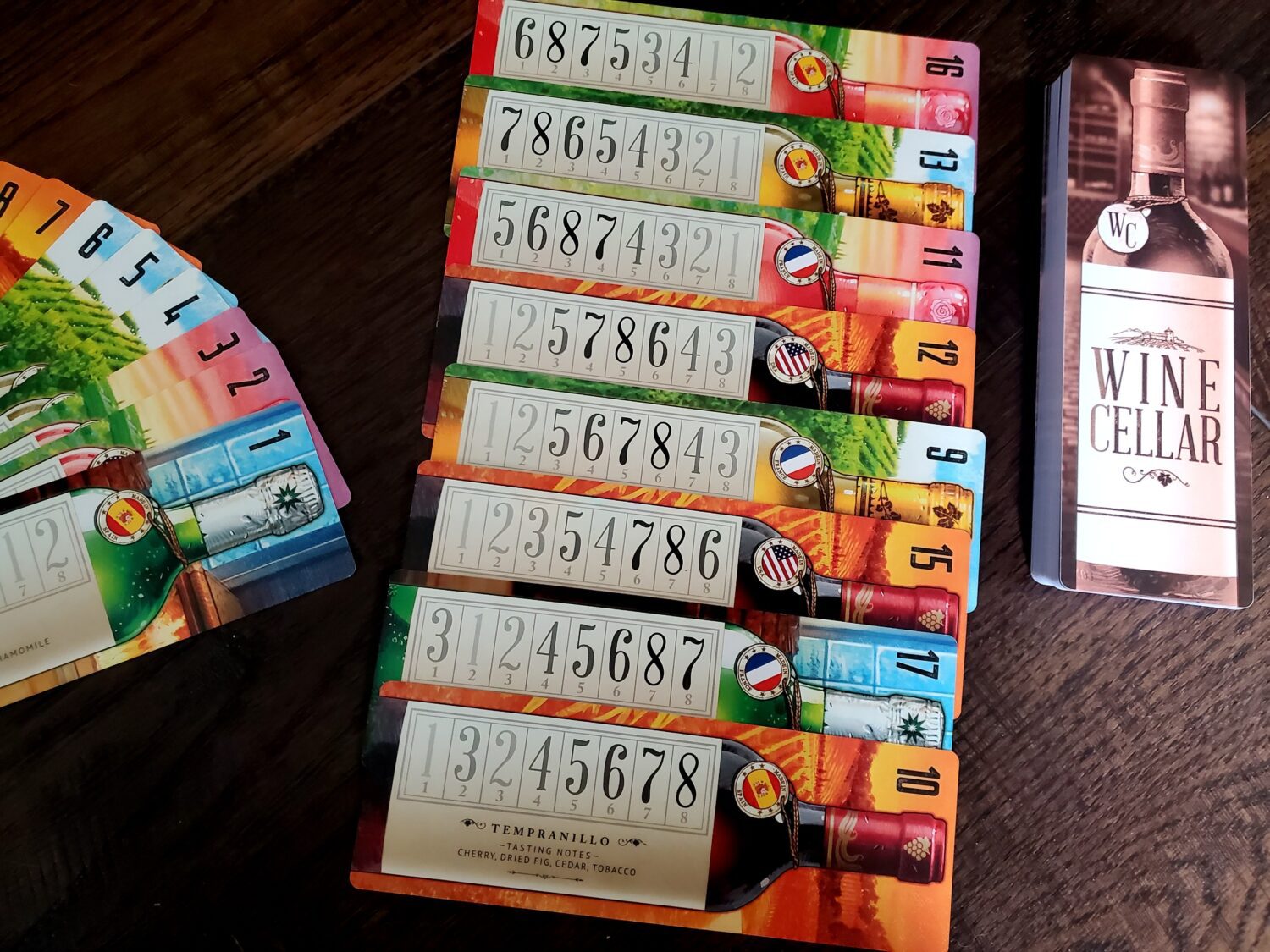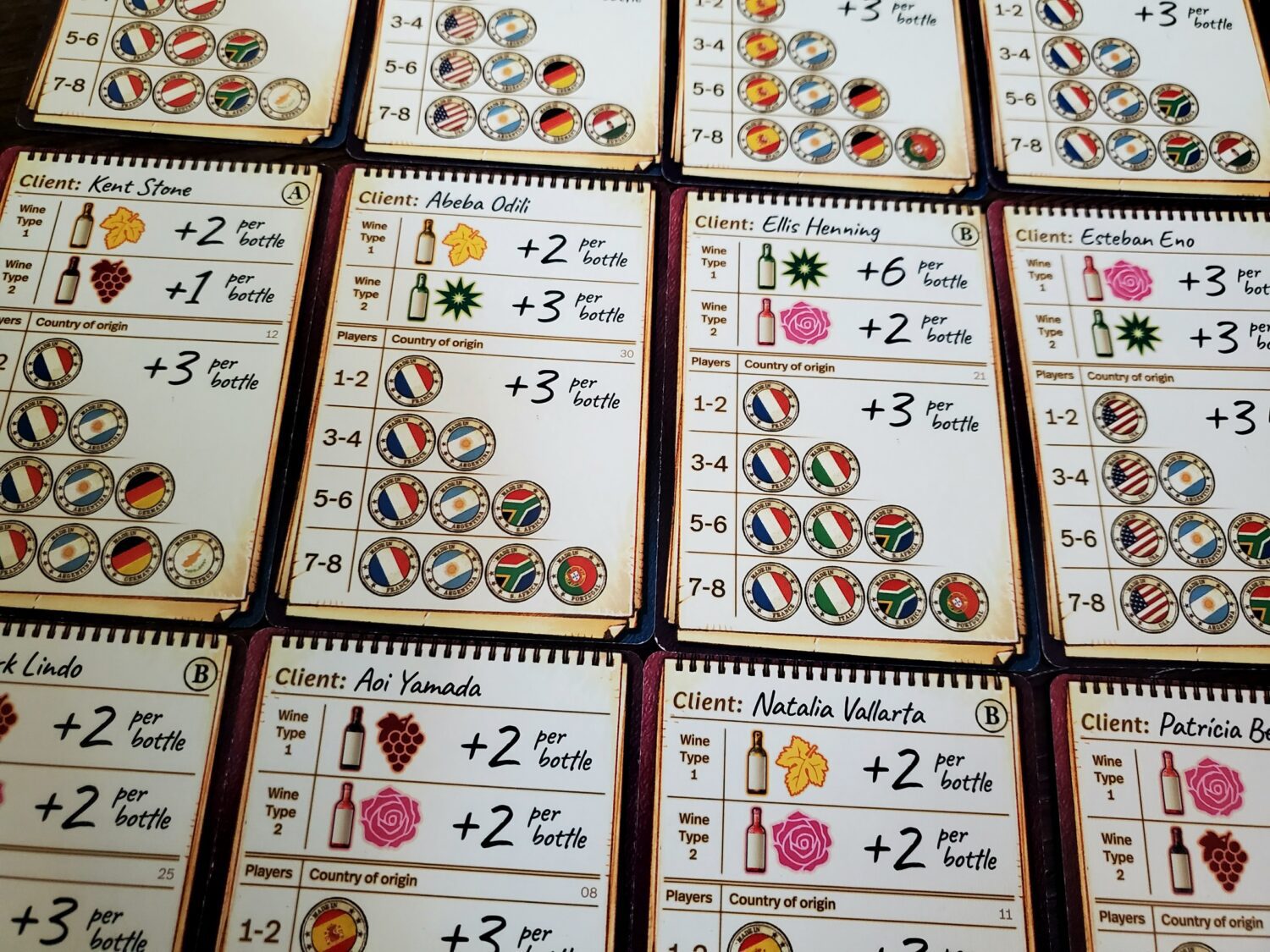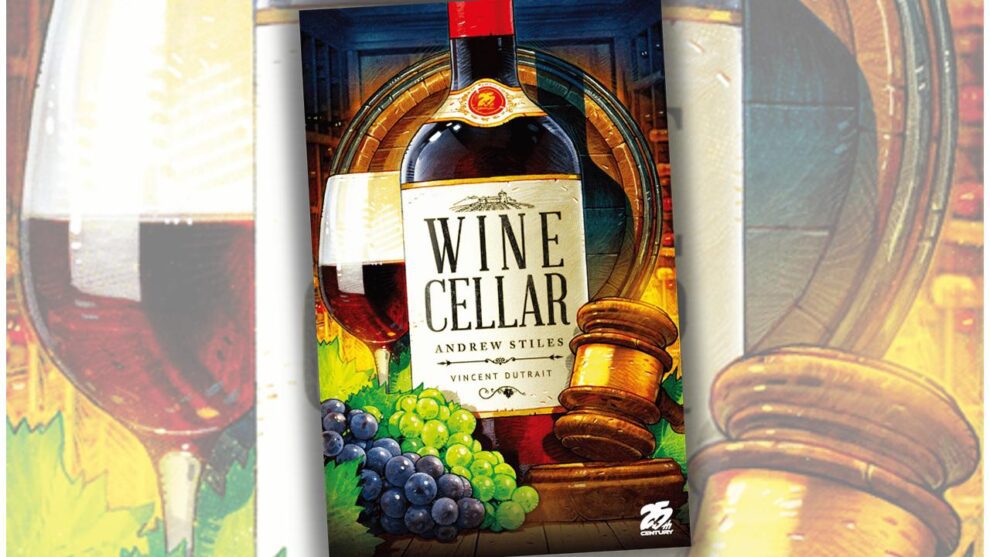Disclosure: Meeple Mountain received a free copy of this product in exchange for an honest, unbiased review. This review is not intended to be an endorsement.
Play is a fascinating concept. If at the evening’s outset I explained that we were going to engage an exercise in which we will bid to arrange numbers into an 8×8 grid so that the diagonal from A1 to H8 scored as highly as possible, a few strange birds might jump at the chance, but many would crinkle their noses with a heartfelt, “No thanks…what do you have on tap?”
If instead I said we were going to bid to secure a series of wine bottles according to their aging process so as to unleash the richest palette at the right moment, I venture to guess I would have more takers. And by the time folks realized they were actually just arranging that 8×8 grid after all, they would realize they were having fun and they wouldn’t care.
Primary Aromas
As an auction experience, Wine Cellar is thoughtful. Players begin with 8 elongated bottle cards, numbered one through as many as are necessary (up to 72, the eight-player limit). The bottles are also marked with a type— white, red, rosé (instead), and sparkling— and countries of origin, which widen in number and distribution as the deck size increases.
The heart of the information, however, and the part that requires the greatest use of player gray matter, is the aging table that runs across the body of the bottle. The numbers one through eight indicate the quality of the wine, as it ages, from left to right. There are over 40,000 ways to arrange the numbers, so while I’ve not checked, I assume each of the 72 cards is unique in this respect? Forgive my lack of due diligence.
Players bid on a set of bottle cards in the center of the table. With bids resolving from high to low, players collect a bottle from the center and lay it horizontally in front of them. The bid cards then become the auction materials for the next round. This continues until the cards are spent and each player has collected eight bottles.
The first collected bottle, easily enough, is simply laid on the table. Each bottle collected afterward must be placed either at the top or bottom of the arrangement, never between two previously placed wines. At the conclusion of the round, each player will have an 8×8 grid of numbers, bottles to be consumed one by one. The first bottle scores its first number value, the second its second, and so on. So yes, you score values A1 through H8 diagonally. This arrangement process gives Wine Cellar its crunch, a rolling snowball of information as those final bottles into each collection provide all the stress, cheers, and jeers of the game.

Secondary Aromas
Obviously the other information on the cards matters. Players are also attempting in each game to satisfy the whims of customers, chasing scoring particulars related to the type of wine and the country of origin. These customer cards are face-up throughout the game so that everyone’s greatest desires lay bare for scrutiny and interference.
The values on these customer cards provide graduated motivation. The sparkling inventory is a bit lighter (eight of 72 cards), igniting fierce competition at times for their oft-inflated scoring potentials. Rosés are similarly rare (sixteen cards), while whites and reds make up the bulk of the deck. One of the magnificent tensions in the game is balancing the desire to uphold the grid while hunting bonuses—or is it hunting bonuses while upholding the grid?
Countries of origin are consistent in their points. Depending on the breakdown of types, the countries might actually become the driving force for bonus points. Wine Cellar thrives in this variety. The auction itself is always the same, but the goals offer a hint of variety that gives individual plays a bit of flair.

Tertiary Aromas
Wine Cellar rarely leaves the table after a single game. The end of the rulebook suggests a three-game series in which players take up their acquired bottles from game one as their opening hand for game two. This, quite honestly, is liquid gold. The variant adds a layer of significance to every bid, because nobody wants to be left with a hand of low values for the next round. The mental investment is a bit more measured in the first two games, leading to the veritable avalanche in that third set when all bets are off for the future.
While the game certainly isn’t built solely for this mechanic, I love that you can at least attempt to bid with a card in hopes of winning it back with the next play. As the player count increases, so, too, does the difficulty of such a move, but it’s out there as a viticultural one-two. In the two-player affair the idea is more prevalent and personal.
In what I would call a rare feat, Wine Cellar is a spectacular auction game for two players. The makeup of the deck is such that there is always a relevant sequence from 1 to x, creating an immediate value matrix no matter the count. With only two cards for the taking in each round of the two-player affair, the stakes are always high. It’s the sort of situation where you can fully pay attention to the other player’s collection and play offense and defense.
As the player count begins to rise, disappointment rises with it. Not disappointment in the game, mind you, just disappointment that someone else inevitably steals away your first choice of bottles. Even with the full count of eight, play remains smooth. Players drop a card, reveal, and then one by one settle business with the choices in the middle. The high player count is all about seizing the most critical moments with your available high cards, provided, of course, that you recognize the critical moments.
Supple
If I had to choose a wine word for Wine Cellar, it’d be supple. It’s got a great feel. No sharp edges, nothing to turn you off. For a game that revolves around organizing a grid, it’s surprisingly engaging and smooth. Andrew Stiles and the crew at 25th Century Games jumped in at the deep end with the theme. From the rules to the art, they want you to think about real bottles of wine and not the grid. I applaud the effort, and it kind of works.
In the end, everyone collects a series of bottles that look fancy on the table and tell a bit of a story. It’s not the sort of story where you break the bottles and use the necks in close combat. It’s one where you put the wine to its proper use and enjoy a bit of time together.











